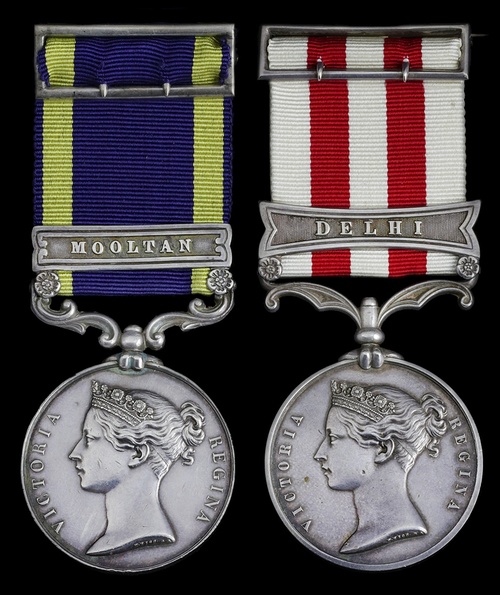
Auction: 19001 - Orders, Decorations and Medals
Lot: 608
(x) Pair: Lieutenant-General C. T. Stewart, Bengal Sappers and Miners
Punjab 1848-49, 1 clasp, Mooltan (2nd Lieutt. C. T. Stewart. Engineers.), officially engraved in running script, fitted with a silver top riband buckle; Indian Mutiny 1857-59, 1 clasp, Delhi (2nd Capt. C. T. Stewart, Bengal Engrs.), fitted with a Hunt & Roskell silver top riband buckle, good very fine (2)
Charles Thornton Stewart was born at Calcutta in April 1828, son of the merchant Robert Stewart. In December 1845 he petitioned for admission to the Honourable East India Company's service as a Cadet, having been nominated by Major-General Sir J. Bryant, one of the Company's Directors. His petition was signed by his mother, who was then living at Belgrave Square, London.
Stewart was accepted for the 1845 Season at Addiscombe Military Seminary, passing out on 5 October 1846. He arrived in India on 7 March 1848 and joined the Bengal Sappers and Miners as a 2nd Lieutenant (L/Mil/9/207 and L/Mil/10/81), serving throughout the siege operations before Mooltan (clasp). The Sappers and Miners, under the command of Captain H. Siddons (see Lot 309 of November 2018 sale), dug saps right up to the walls of Mooltan's citadel. On 18 January 1849 they undermined the citadel's walls with a terrific explosion, opening a wide breach. Now threatened with storming, Mooltan's ruler Diwan Mulraj Chopra surrendered unconditionally to the British. This surrender came not a moment too soon, for the besieging army then marched rapidly to Gough's relief at Goojerat, an action in which Stewart was present (his service papers confirm).
Stewart served with the Regiment until 9 April 1850, when he was appointed Assistant Superintendent of the Eastern Jumna Canal. In June 1854 he transferred to the Western Jumna Canal as Officiating Superintendent, a role he ably performed until 24 October 1859. His promising career in the Public Works Department was interrupted in 1857. He was working in Delhi when it fell to the Meerut rebels on 11 May, narrowly escaping with his life. Reaching Flagstaff Tower on the Delhi Ridge, north of the city, he joined other British escapees and served during the capture of Delhi (clasp), having been promoted to 1st Lieutenant on 15 February 1854.
Richard Baird Smith was Chief Engineer of the British force besieging Delhi, and he devised plans for the assault. Two of the main rebel strongpoints, Mori Bastion and Kashmir Bastion, had to be quickly neutralised. Smith's Engineers constructed two batteries for the task, known as 'Sammy House' and 'Ludlow Castle'. As they dug these earthworks the Sappers came under murderous enfilading fire from rebels on the walls, suffering over 300 casualties. Breaches were nevertheless made in the bastions and walls, and on 14 September the British attacked in five columns. The Bengal Sappers and Miners showed particular bravery, running in front of each column to clear obstacles under heavy fire. Two Sapper officers, Lieutenants Home and Salkeld, won the Victoria Cross for leading their Sappers to the Kashmir Gate and demolishing it with powder charges. Stewart was promoted to 2nd Captain on 27 August 1858.
The India List shows him employed in the Public Works Department for the remainder of his career. He was appointed Executive Engineer of the Agra Division in April 1860, rising to become Superintending Engineer of the Punjab on 1 September 1870. He was promoted to Major on 14 December 1861, Lieutenant-Colonel on 10 November 1869, Colonel on 31 December 1878 and Major-General on 10 May 1881. He retired in 1883 with a large annuity and the honorary rank of Lieutenant-General (London Gazette, 18 May 1883). His discharge papers state: 'Colonel Stewart is a hardworking, zealous officer… he has taken the very best care of the Canal that it was possible to take.' The 1901 census records him living at The Rectory, Dalbury, Derbyshire; sold with copied discharge papers and research.
Subject to 5% tax on Hammer Price in addition to 20% VAT on Buyer’s Premium. For more information please view Terms and Conditions for Buyers.
Sold for
£1,400




